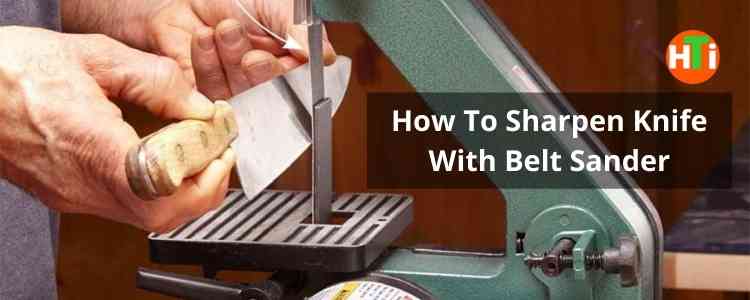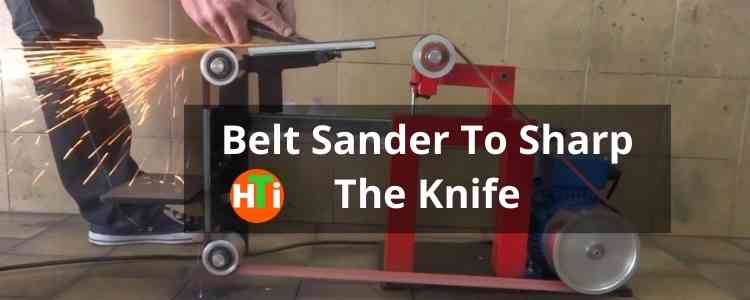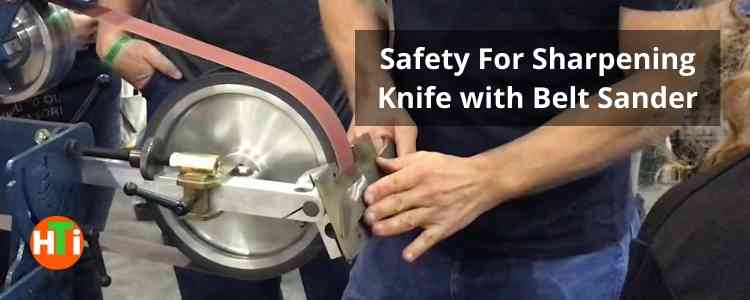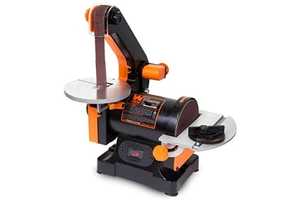How to sharpen knife with belt sander requires some tricks and methods from you. Obviously, the strategy that you follow on your own isn’t similar to others. But we don’t underestimate your skills, as everyone has their style to do the task easily.
It is high time people used their hands to shape a knife. Besides, using the belt sander to sharpen the knife gives you awful results and saves time. But you need to be a little expert to drive the sander properly. In that case, follow our respective strategies to sharpen the knife amazingly and some tips to become better at it.
Those who don’t want to look around the market for too long can choose one of our top 5 picks.
Belt Sander | Quick Specs | Price |
Rank No-1: Best Belt Sander for beginner Grizzly G1015 knife belt sander buffer review |
| |
Rank No-2: Editor’s Choice Wen belt sander for knife making |
| |
Rank No-3: Best value Rikon 50 151 belt disc sander |
| |
Rank No-4: Best Heavy-duty Grinder HappyBuy 2 in 1 belt grinder for knife making |
| |
Rank No-5: Most Professional Grinder Mini Belt Sander Electric Grinder Knife Review |
|
Steps To Follow For Sharpen The Knife Using Belt Sander

Keep in mind that belt sanders come with belts, but it’s less effective on carbon steel. Sometimes it may wear out extremely fast. This sander for metal is available in many sizes and styles. So with a little research, you are likely able to find them to fit whatever belt sander you should use as a belt grinder. So here, you can sharpen the knife with this.
Ingredients To Need-
- 220-medium grit belt
- A honing compound
- A leather strip
- A belt sander
Also Read: Top 11 FAQ Belt Grinder Or Belt Sander For Knife Making
Step 01
Install medium-grit sander into the sander. Be aware that you won’t install the grit too tight or too loose. That means you have to install the grit in medium pressure so that you can push the sander a bit back with a bit of tension.
Step 02
In these steps, you have to select the spinning direction righteously. You can call it an angle guide for belt sander. Keep the spin far from you when using the tool horizontally. On the opposite, fix the spin towards you if you set it vertically.
It’s well to know that using a lower grit may give you the experience of a rougher surface, as long as it will be the reason for a more abrasive impact on the blade. So pick the knife and keep it in front of the device.
Step 03
Now turn on the switch and start the work. Make sure that you keep the speed to its maximum range. It often refers to the work of setting up a knife-making shop. Now let the knife be sharpened. Put the blade in front of the spins and move across it. Don’t pressurize too much while you’re running across the sander. Gently push them out so that you can make enough bend on the belt.
Afterward, try to apply a bit of tilt to enable the device to make bevels cut. Let the blade for strokes sometimes and flip this aside. Keep an extra eye while holding the blade with your two hands. It’s because the sander will shed off the metal too fast.
Step 04
When sharpening a knife, hand balancing is a vital thing you must have considered. Further, a knife grinding jig for belt sander is a tool you have to balance over the blade’s tip to control the stroke. For gaining a good balance overhand, keep it on the hilt and the other onto the blade’s tip. Check a burr after it has finished several strokes. You can use a knife belt sander buffer to check the accuracy of sharpening.
Step 05
This is the last step on which you have to focus on keeping it cool. It is a vital part of sharpening a knife. You can do this step by dropping it inside the water. Or touch the motor housing with a bare hand every 20 minutes.
On the contrary, take a break to let it cool down if you notice that the motor starts feeling noticeably hot.
Actually, when you’re using the belt sander to sharpen the knife, it becomes overheated because of the rising frictions.
On the other hand, belt sanders are very lightweight. And the motor inside it will be prone to overheating if used for metal constantly. The procedure is as important as sharpening a knife. Otherwise, the knife won’t be too solid. The matter also provides a good impact to increase the lifespan of the knife.
Step 06
This is the last step of this method. Here you need to hone the blade. After finishing the whole process, you’ll discover a good burr at the body of your knife. Hone will help to disappear this burr from the knife. For this, take a medium grit sander or use the belt sander rollers as an alternate.
Next, insert it into the leather strip and link it to the honing compound. It is done at the same process as you have sharpened the knife. Most importantly, don’t skip these steps because they will help get the sharpest blade after a few strokes.
Why Should You Choose A Belt Sander To Sharp The Knife?
If you ask any professional the same question, the vast majority of them will insist on you about the speed. Of course, it’s the only thing by which you’ll get amused about this sander. A belt sander is too fast compared to any conventional devices that are used for sharpening.

In the matter of speed, a belt sander will give you outstanding performance that isn’t compatible. Most of the belt sander runs at high speed for delivering an immaculate edge.
The other best thing about this is it is easy to operate. So, whether you’re a beginner or expert, there’s no need to take help from any hard and fast guidelines. You may now wonder how to use a belt sander. It’s not a great deal at all.
While using a belt sander to sharpen knives, switch to it and pass the blade through it. The belt sander will do the remaining work without any more effort. As well as it is super fast and more efficient than using sharpening stones.
On the other hand, a belt sander will be able to give you a razor-sharp finish. Ask me how? A belt sander usually generates the blade’s edges into a convex shape rather than turning it concave. By doing this, you will get a smooth and solid metallic knife at the end of the job.
The most addictive part of this sander is its sharpness. Whoever wants the knife won’t get sharper when it comes to cutting off anything. No one, I think, is right. Fortunately, a belt sander is a knife that won’t disappoint you in these affairs. Again, comparing the belt grinder vs belt sander based on sharpness won’t give you many differences.
Do I need to Follow Safety Precautions When Sharpening Knife with Belt Sander
Using a belt sander is often dangerous if you haven’t used it before. Hence, there are two options you’ll find – an electric belt sander and an air-powered sander.

Comparatively, the electric belt sander knife sharpener used to be more speedy than others. For this, it may cut away a lot of metal and damage the blade.
As opposed to jagged or air belt sanders, which are too slow for sharpening knives, for having many pros and cons, there is no alternative to being aware. So try to be more conscious about the affairs below.
- Consider choosing a clean and dust-free place whenever you set up your mind to do the work.
- Keep your finger at least 2-3 inches away from the sander. Otherwise, it may cut off your finger.
- Always keep the knife straight in front of the sander. Avoid raising it at an angle unless the knife may get blunt or uneven.
- Do not let the knife be too far away from the sander. By doing this, you may decrease the lifespan of the knife unconsciously. You may have fallen for unwanted abrasion too.
- Wear a safety glass on your eyes to avoid the welding dust.
- Keep the children and pets at a safe distance from your workplace.
Conclusion
So here we discuss all the possible procedures of how to sharpen knife with belt sander. There are plenty of options to do this, we agreed. But applying the simplest and most effective ways will be a holy grail for beginners.
Hence, a belt sander is a means to get the sharpening edges faster. For the beginner, it’s workable if you gain some practice. So try to use the best-specialized belt knife sharpener that works inequality and similarity. Using 50-200 grit is ideal for having the sharp edges to remove all grooves vanquishable.





